Pablo Arbeláez
Comparative validation of surgical phase recognition, instrument keypoint estimation, and instrument instance segmentation in endoscopy: Results of the PhaKIR 2024 challenge
Jul 22, 2025Abstract:Reliable recognition and localization of surgical instruments in endoscopic video recordings are foundational for a wide range of applications in computer- and robot-assisted minimally invasive surgery (RAMIS), including surgical training, skill assessment, and autonomous assistance. However, robust performance under real-world conditions remains a significant challenge. Incorporating surgical context - such as the current procedural phase - has emerged as a promising strategy to improve robustness and interpretability. To address these challenges, we organized the Surgical Procedure Phase, Keypoint, and Instrument Recognition (PhaKIR) sub-challenge as part of the Endoscopic Vision (EndoVis) challenge at MICCAI 2024. We introduced a novel, multi-center dataset comprising thirteen full-length laparoscopic cholecystectomy videos collected from three distinct medical institutions, with unified annotations for three interrelated tasks: surgical phase recognition, instrument keypoint estimation, and instrument instance segmentation. Unlike existing datasets, ours enables joint investigation of instrument localization and procedural context within the same data while supporting the integration of temporal information across entire procedures. We report results and findings in accordance with the BIAS guidelines for biomedical image analysis challenges. The PhaKIR sub-challenge advances the field by providing a unique benchmark for developing temporally aware, context-driven methods in RAMIS and offers a high-quality resource to support future research in surgical scene understanding.
SMILE-UHURA Challenge -- Small Vessel Segmentation at Mesoscopic Scale from Ultra-High Resolution 7T Magnetic Resonance Angiograms
Nov 14, 2024Abstract:The human brain receives nutrients and oxygen through an intricate network of blood vessels. Pathology affecting small vessels, at the mesoscopic scale, represents a critical vulnerability within the cerebral blood supply and can lead to severe conditions, such as Cerebral Small Vessel Diseases. The advent of 7 Tesla MRI systems has enabled the acquisition of higher spatial resolution images, making it possible to visualise such vessels in the brain. However, the lack of publicly available annotated datasets has impeded the development of robust, machine learning-driven segmentation algorithms. To address this, the SMILE-UHURA challenge was organised. This challenge, held in conjunction with the ISBI 2023, in Cartagena de Indias, Colombia, aimed to provide a platform for researchers working on related topics. The SMILE-UHURA challenge addresses the gap in publicly available annotated datasets by providing an annotated dataset of Time-of-Flight angiography acquired with 7T MRI. This dataset was created through a combination of automated pre-segmentation and extensive manual refinement. In this manuscript, sixteen submitted methods and two baseline methods are compared both quantitatively and qualitatively on two different datasets: held-out test MRAs from the same dataset as the training data (with labels kept secret) and a separate 7T ToF MRA dataset where both input volumes and labels are kept secret. The results demonstrate that most of the submitted deep learning methods, trained on the provided training dataset, achieved reliable segmentation performance. Dice scores reached up to 0.838 $\pm$ 0.066 and 0.716 $\pm$ 0.125 on the respective datasets, with an average performance of up to 0.804 $\pm$ 0.15.
PitVis-2023 Challenge: Workflow Recognition in videos of Endoscopic Pituitary Surgery
Sep 02, 2024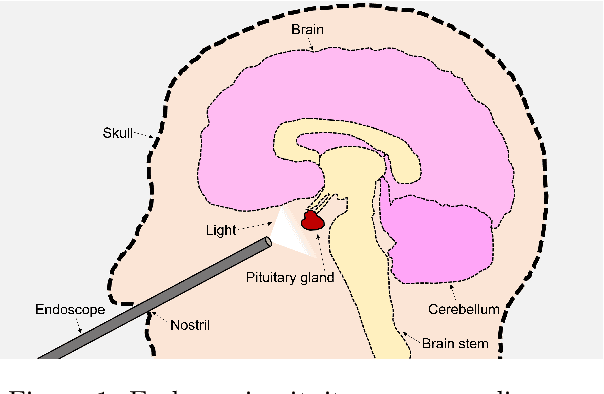

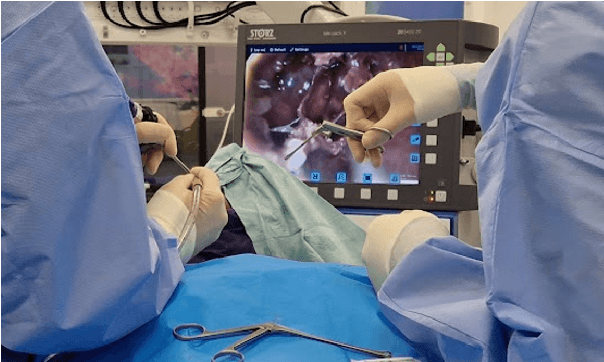
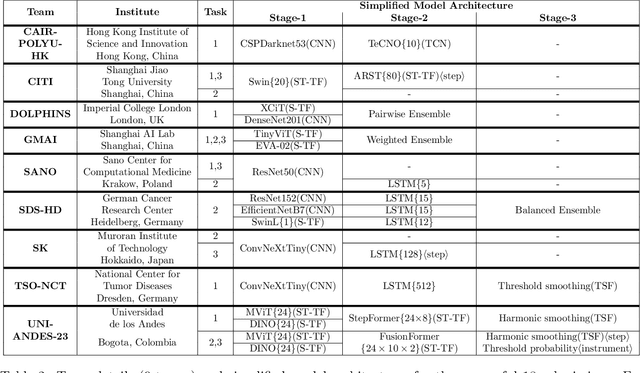
Abstract:The field of computer vision applied to videos of minimally invasive surgery is ever-growing. Workflow recognition pertains to the automated recognition of various aspects of a surgery: including which surgical steps are performed; and which surgical instruments are used. This information can later be used to assist clinicians when learning the surgery; during live surgery; and when writing operation notes. The Pituitary Vision (PitVis) 2023 Challenge tasks the community to step and instrument recognition in videos of endoscopic pituitary surgery. This is a unique task when compared to other minimally invasive surgeries due to the smaller working space, which limits and distorts vision; and higher frequency of instrument and step switching, which requires more precise model predictions. Participants were provided with 25-videos, with results presented at the MICCAI-2023 conference as part of the Endoscopic Vision 2023 Challenge in Vancouver, Canada, on 08-Oct-2023. There were 18-submissions from 9-teams across 6-countries, using a variety of deep learning models. A commonality between the top performing models was incorporating spatio-temporal and multi-task methods, with greater than 50% and 10% macro-F1-score improvement over purely spacial single-task models in step and instrument recognition respectively. The PitVis-2023 Challenge therefore demonstrates state-of-the-art computer vision models in minimally invasive surgery are transferable to a new dataset, with surgery specific techniques used to enhance performance, progressing the field further. Benchmark results are provided in the paper, and the dataset is publicly available at: https://doi.org/10.5522/04/26531686.
Deep Learning at the Intersection: Certified Robustness as a Tool for 3D Vision
Aug 23, 2024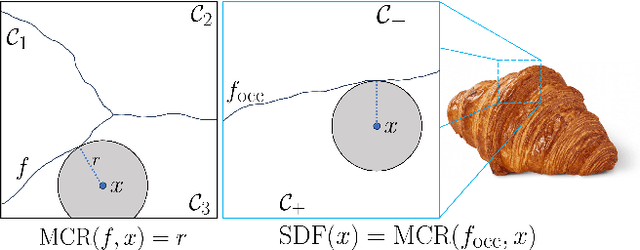



Abstract:This paper presents preliminary work on a novel connection between certified robustness in machine learning and the modeling of 3D objects. We highlight an intriguing link between the Maximal Certified Radius (MCR) of a classifier representing a space's occupancy and the space's Signed Distance Function (SDF). Leveraging this relationship, we propose to use the certification method of randomized smoothing (RS) to compute SDFs. Since RS' high computational cost prevents its practical usage as a way to compute SDFs, we propose an algorithm to efficiently run RS in low-dimensional applications, such as 3D space, by expressing RS' fundamental operations as Gaussian smoothing on pre-computed voxel grids. Our approach offers an innovative and practical tool to compute SDFs, validated through proof-of-concept experiments in novel view synthesis. This paper bridges two previously disparate areas of machine learning, opening new avenues for further exploration and potential cross-domain advancements.
MuST: Multi-Scale Transformers for Surgical Phase Recognition
Jul 24, 2024Abstract:Phase recognition in surgical videos is crucial for enhancing computer-aided surgical systems as it enables automated understanding of sequential procedural stages. Existing methods often rely on fixed temporal windows for video analysis to identify dynamic surgical phases. Thus, they struggle to simultaneously capture short-, mid-, and long-term information necessary to fully understand complex surgical procedures. To address these issues, we propose Multi-Scale Transformers for Surgical Phase Recognition (MuST), a novel Transformer-based approach that combines a Multi-Term Frame encoder with a Temporal Consistency Module to capture information across multiple temporal scales of a surgical video. Our Multi-Term Frame Encoder computes interdependencies across a hierarchy of temporal scales by sampling sequences at increasing strides around the frame of interest. Furthermore, we employ a long-term Transformer encoder over the frame embeddings to further enhance long-term reasoning. MuST achieves higher performance than previous state-of-the-art methods on three different public benchmarks.
Enhancing Gene Expression Prediction from Histology Images with Spatial Transcriptomics Completion
Jul 17, 2024



Abstract:Spatial Transcriptomics is a novel technology that aligns histology images with spatially resolved gene expression profiles. Although groundbreaking, it struggles with gene capture yielding high corruption in acquired data. Given potential applications, recent efforts have focused on predicting transcriptomic profiles solely from histology images. However, differences in databases, preprocessing techniques, and training hyperparameters hinder a fair comparison between methods. To address these challenges, we present a systematically curated and processed database collected from 26 public sources, representing an 8.6-fold increase compared to previous works. Additionally, we propose a state-of-the-art transformer based completion technique for inferring missing gene expression, which significantly boosts the performance of transcriptomic profile predictions across all datasets. Altogether, our contributions constitute the most comprehensive benchmark of gene expression prediction from histology images to date and a stepping stone for future research on spatial transcriptomics.
Pixel-Wise Recognition for Holistic Surgical Scene Understanding
Jan 26, 2024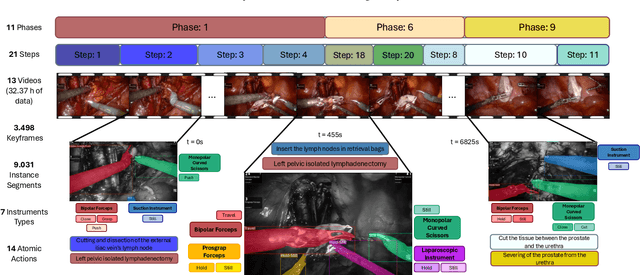
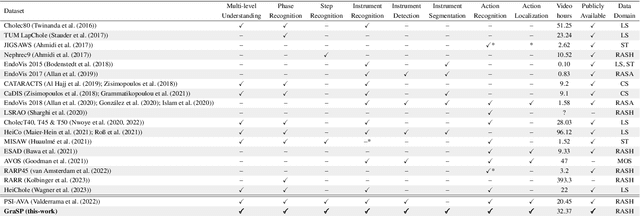
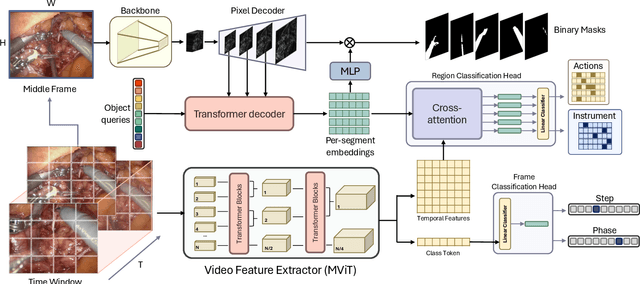
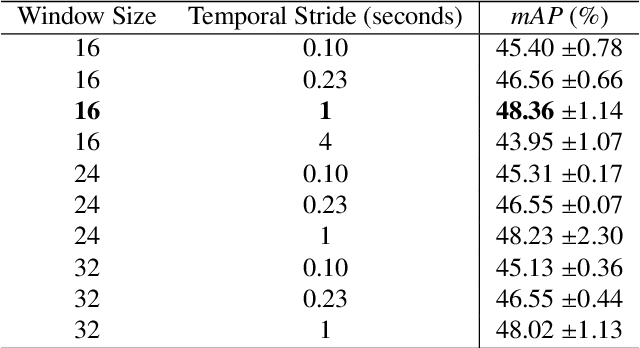
Abstract:This paper presents the Holistic and Multi-Granular Surgical Scene Understanding of Prostatectomies (GraSP) dataset, a curated benchmark that models surgical scene understanding as a hierarchy of complementary tasks with varying levels of granularity. Our approach enables a multi-level comprehension of surgical activities, encompassing long-term tasks such as surgical phases and steps recognition and short-term tasks including surgical instrument segmentation and atomic visual actions detection. To exploit our proposed benchmark, we introduce the Transformers for Actions, Phases, Steps, and Instrument Segmentation (TAPIS) model, a general architecture that combines a global video feature extractor with localized region proposals from an instrument segmentation model to tackle the multi-granularity of our benchmark. Through extensive experimentation, we demonstrate the impact of including segmentation annotations in short-term recognition tasks, highlight the varying granularity requirements of each task, and establish TAPIS's superiority over previously proposed baselines and conventional CNN-based models. Additionally, we validate the robustness of our method across multiple public benchmarks, confirming the reliability and applicability of our dataset. This work represents a significant step forward in Endoscopic Vision, offering a novel and comprehensive framework for future research towards a holistic understanding of surgical procedures.
Adaptive Guidance: Training-free Acceleration of Conditional Diffusion Models
Dec 19, 2023Abstract:This paper presents a comprehensive study on the role of Classifier-Free Guidance (CFG) in text-conditioned diffusion models from the perspective of inference efficiency. In particular, we relax the default choice of applying CFG in all diffusion steps and instead search for efficient guidance policies. We formulate the discovery of such policies in the differentiable Neural Architecture Search framework. Our findings suggest that the denoising steps proposed by CFG become increasingly aligned with simple conditional steps, which renders the extra neural network evaluation of CFG redundant, especially in the second half of the denoising process. Building upon this insight, we propose "Adaptive Guidance" (AG), an efficient variant of CFG, that adaptively omits network evaluations when the denoising process displays convergence. Our experiments demonstrate that AG preserves CFG's image quality while reducing computation by 25%. Thus, AG constitutes a plug-and-play alternative to Guidance Distillation, achieving 50% of the speed-ups of the latter while being training-free and retaining the capacity to handle negative prompts. Finally, we uncover further redundancies of CFG in the first half of the diffusion process, showing that entire neural function evaluations can be replaced by simple affine transformations of past score estimates. This method, termed LinearAG, offers even cheaper inference at the cost of deviating from the baseline model. Our findings provide insights into the efficiency of the conditional denoising process that contribute to more practical and swift deployment of text-conditioned diffusion models.
Multimodal Foundation Models for Zero-shot Animal Species Recognition in Camera Trap Images
Nov 02, 2023



Abstract:Due to deteriorating environmental conditions and increasing human activity, conservation efforts directed towards wildlife is crucial. Motion-activated camera traps constitute an efficient tool for tracking and monitoring wildlife populations across the globe. Supervised learning techniques have been successfully deployed to analyze such imagery, however training such techniques requires annotations from experts. Reducing the reliance on costly labelled data therefore has immense potential in developing large-scale wildlife tracking solutions with markedly less human labor. In this work we propose WildMatch, a novel zero-shot species classification framework that leverages multimodal foundation models. In particular, we instruction tune vision-language models to generate detailed visual descriptions of camera trap images using similar terminology to experts. Then, we match the generated caption to an external knowledge base of descriptions in order to determine the species in a zero-shot manner. We investigate techniques to build instruction tuning datasets for detailed animal description generation and propose a novel knowledge augmentation technique to enhance caption quality. We demonstrate the performance of WildMatch on a new camera trap dataset collected in the Magdalena Medio region of Colombia.
SEPAL: Spatial Gene Expression Prediction from Local Graphs
Sep 16, 2023Abstract:Spatial transcriptomics is an emerging technology that aligns histopathology images with spatially resolved gene expression profiling. It holds the potential for understanding many diseases but faces significant bottlenecks such as specialized equipment and domain expertise. In this work, we present SEPAL, a new model for predicting genetic profiles from visual tissue appearance. Our method exploits the biological biases of the problem by directly supervising relative differences with respect to mean expression, and leverages local visual context at every coordinate to make predictions using a graph neural network. This approach closes the gap between complete locality and complete globality in current methods. In addition, we propose a novel benchmark that aims to better define the task by following current best practices in transcriptomics and restricting the prediction variables to only those with clear spatial patterns. Our extensive evaluation in two different human breast cancer datasets indicates that SEPAL outperforms previous state-of-the-art methods and other mechanisms of including spatial context.
 Add to Chrome
Add to Chrome Add to Firefox
Add to Firefox Add to Edge
Add to Edge